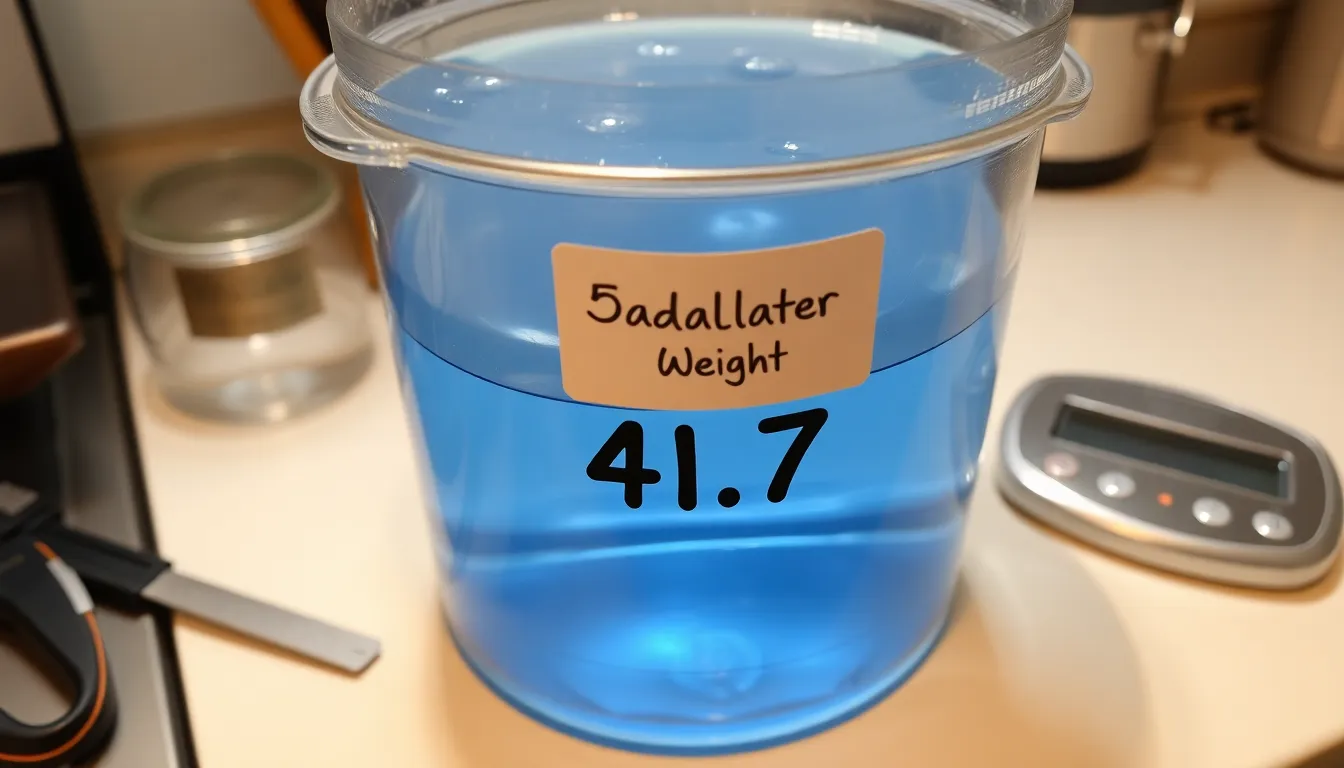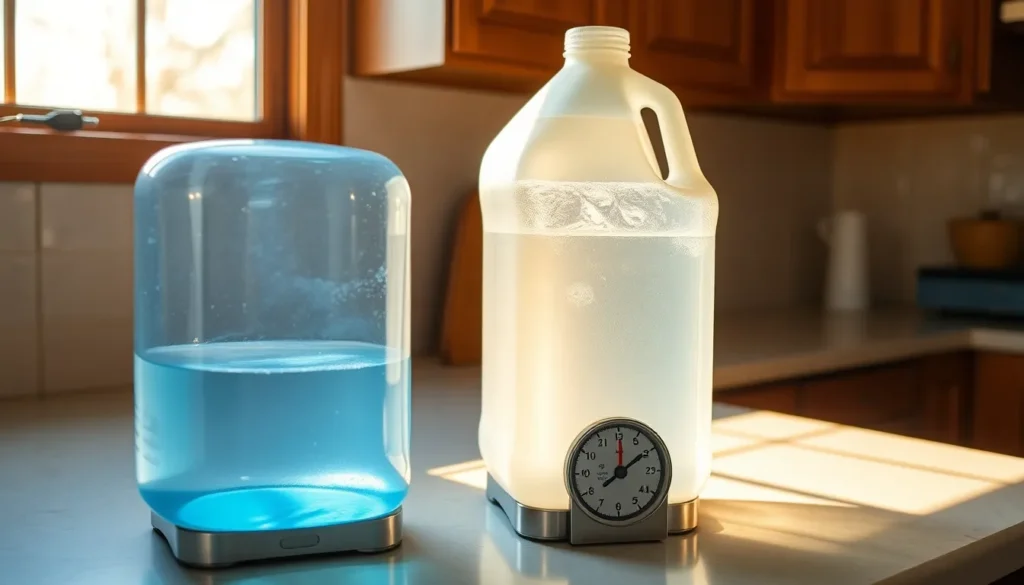Table of Contents
ToggleWater is essential for life, but have you ever stopped to think about just how heavy five gallons of it really is? Picture this: you’re strutting around with a hefty jug of water, feeling like a hydration hero. But wait—did you know that five gallons weighs a staggering 41.7 pounds? That’s like carrying a small dog or a very determined toddler!
Understanding Water Weight
Water weight represents the mass of water being measured, typically expressed in pounds or kilograms. Five gallons of water weighs precisely 41.7 pounds, making this measurement significant for various applications.
Definition of Water Weight
Water weight refers to the gravitational force acting upon water measured in a specific volume. Standard units like pounds or kilograms express this weight. The density of water remains relatively consistent at room temperature, with one gallon of water weighing approximately 8.34 pounds. Five gallons therefore equal 41.7 pounds. Factors such as temperature may slightly affect this weight, but the overall measurement remains reliable for practical purposes.
Importance of Water Weight Measurement
Measuring water weight proves crucial in multiple fields like cooking, science, and transportation. Accurate water weight aids in recipe formulation, ensuring the correct balance of ingredients. In scientific experiments, water weight provides vital data for calculations and research. Transportation companies factor in water weight when shipping products, directly influencing logistics and costs. Understanding water weight enhances safety and efficiency across these applications, proving its relevance in everyday and professional scenarios.
Calculating 5 Gallons of Water Weight

Five gallons of water consistently weighs 41.7 pounds. This weight remains standard due to water’s density at room temperature.
Conversion to Pounds
Converting gallons to pounds requires knowing water’s density. One gallon of water weighs approximately 8.34 pounds. When you multiply 8.34 pounds by 5 gallons, you arrive at 41.7 pounds. This conversion simplifies calculations for various applications, whether in cooking or scientific research. Professionals in transportation often rely on this precise measurement for accurate logistics.
Factors Affecting Water Weight
Several factors can influence water’s weight. Temperature is a primary factor, as water density changes slightly with temperature variations. Warmer water is less dense than colder water, leading to slight weight differences. Other aspects, such as impurities in the water or pressure variations, can also impact weight. While these variations exist, they typically do not affect everyday calculations significantly. Accurate water measurement is vital in fields such as cooking, chemistry, and logistics to ensure safety and efficiency.
Practical Applications of 5 Gallons of Water Weight
Understanding the weight of five gallons of water has several practical applications. This knowledge aids in various fields, ensuring accuracy and efficiency.
Fitness and Health Considerations
Weight training often incorporates water for hydration. Five gallons of water weighs 41.7 pounds, so it’s a valuable reference for fitness enthusiasts. Carrying this weight simulates real-life resistance, enhancing workout intensity. Athletes benefit from using water weight in preparing their bodies for competitions. Tracking hydration levels during exercise remains essential, and knowing the weight helps assess daily fluid intake. Proper hydration fosters optimal performance and recovery, especially for those engaged in high-endurance sports.
Everyday Uses and Examples
Five gallons of water plays a crucial role in daily tasks. Homeowners often use this measurement when planning for gardening needs, ensuring proper plant hydration. Cooking recipes frequently require precise water amounts; knowing that five gallons equals 41.7 pounds simplifies measurement. When moving or storing water, understanding its weight aids in selecting appropriate containers and transporting methods. Additionally, construction or landscaping projects benefit from this water weight knowledge when calculating necessary resources. Accurate estimates prevent waste and ensure project efficiency.
Common Myths About Water Weight
Understanding water weight involves navigating common myths and misconceptions. Misunderstandings often lead to confusion around its impact on body composition and health.
Myths vs. Facts
People frequently believe water weight indicates true fat gain. In reality, water weight fluctuates due to hydration levels, diet, and activity. Retaining water doesn’t predict long-term weight changes. Quick losses on the scale often result from lost water rather than fat. Commonly, individuals ignore that water retention can happen with increased sodium intake. Accurate assessment requires a longer view on weight trends rather than relying on daily fluctuations.
Misconceptions in Fitness Communities
Within fitness communities, a popular belief claims high water intake leads to weight gain. On the contrary, proper hydration often aids in reducing actual body weight. Many enthusiasts think muscle weighs more than fat, but one pound of muscle and one pound of fat weigh the same. Misinterpretations can arise regarding sodium intake and its correlation with water retention. Ultimately, understanding how hydration interacts with overall health is essential for effective fitness strategies.
Understanding the weight of five gallons of water is more than just a simple measurement. It plays a vital role in various aspects of daily life and professional fields. Whether it’s for cooking gardening or fitness tracking the knowledge of this weight helps individuals make informed decisions.
Dispelling myths surrounding water weight is equally important as it fosters a better understanding of hydration’s impact on health. By grasping these concepts individuals can optimize their hydration strategies and enhance their overall well-being. Ultimately knowing that five gallons of water weighs 41.7 pounds provides a practical foundation for managing resources effectively and debunking common misconceptions.







